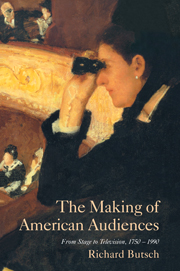Book contents
- Frontmatter
- Contents
- Acknowledgments
- Introduction: Participative Public, Passive Private?
- 1 Colonial Theater, Privileged Audiences
- 2 Drama in Early Republic Audiences
- 3 The B'Hoys in Jacksonian Theaters
- 4 Knowledge and the Decline of Audience Sovereignty
- 5 Matinee Ladies: Re-gendering Theater Audiences
- 6 Blackface, Whiteface
- 7 Variety, Liquor, and Lust
- 8 Vaudeville, Incorporated
- 9 “Legitimate” and “Illegitimate” Theater around the Turn of the Century
- 10 The Celluloid Stage: Nickelodeon Audiences
- 11 Storefronts to Theaters: Seeking the Middle Class
- 12 Voices from the Ether: Early Radio Listening
- 13 Radio Cabinets and Network Chains
- 14 Rural Radio: “We Are Seldom Lonely Anymore”
- 15 Fears and Dreams: Public Discourses about Radio
- 16 The Electronic Cyclops: Fifties Television
- 17 A TV in Every Home: Television “Effects”
- 18 Home Video: Viewer Autonomy?
- 19 Conclusion: From Effects to Resistance and Beyond
- Appendix: Availability, Affordability, Admission Price
- Notes
- Selected Bibliography
- Index
- Plate section
Introduction: Participative Public, Passive Private?
Published online by Cambridge University Press: 05 June 2012
- Frontmatter
- Contents
- Acknowledgments
- Introduction: Participative Public, Passive Private?
- 1 Colonial Theater, Privileged Audiences
- 2 Drama in Early Republic Audiences
- 3 The B'Hoys in Jacksonian Theaters
- 4 Knowledge and the Decline of Audience Sovereignty
- 5 Matinee Ladies: Re-gendering Theater Audiences
- 6 Blackface, Whiteface
- 7 Variety, Liquor, and Lust
- 8 Vaudeville, Incorporated
- 9 “Legitimate” and “Illegitimate” Theater around the Turn of the Century
- 10 The Celluloid Stage: Nickelodeon Audiences
- 11 Storefronts to Theaters: Seeking the Middle Class
- 12 Voices from the Ether: Early Radio Listening
- 13 Radio Cabinets and Network Chains
- 14 Rural Radio: “We Are Seldom Lonely Anymore”
- 15 Fears and Dreams: Public Discourses about Radio
- 16 The Electronic Cyclops: Fifties Television
- 17 A TV in Every Home: Television “Effects”
- 18 Home Video: Viewer Autonomy?
- 19 Conclusion: From Effects to Resistance and Beyond
- Appendix: Availability, Affordability, Admission Price
- Notes
- Selected Bibliography
- Index
- Plate section
Summary
Perhaps, one should write theatrical history in terms of the customs of audiences.
– George C. D. Odell, Annals of the New York Stage (1927), II 426.That is why “popular culture” matters. Otherwise, to tell you the truth, I don't give a damn about it.
– Stuart Hall, “Notes on Deconstructing ‘The Popular’” in Raphael Samuel, ed., People's History and Socialist Theory (London: Routledge, 1981), 239.In 1996, the American Medical Association sent out to 60,000 physicians a guide to advise their patients in children's use of television. The booklet concludes with a list of “media use suggestions for parents” that reads like the warning labels on drugs and dangerous household chemicals: use only in limited amounts, for specific purposes, and under careful guidance of adults. This is just one example of the popular, professional, and scholarly discourses in the twentieth century that have been concerned with mass media's dangers to audiences. Precisely what is the danger and how great it is may vary, but the issue is the foundation of almost all discussion about audiences. And the topic of audiences is pervasive, from popular magazines and books, to debates in Congress, to thousands of scientific studies of the effects of television, to scholarly debates about reception in the humanities.
It is the purpose of this book to provide a history of audiences, particularly one that exposes the terms of twentieth-century debate by comparing them to the terms of debate in earlier eras. Popular and scholarly discussions of audiences have long lacked a historical context. Concerns about television viewing, for example, have almost never led to consideration of earlier concerns about radio listening or moviegoing, let alone popular nineteenth-century entertainments such as melodrama, minstrelsy, and vaudeville. Yet the very issues at the heart of debates today have been played out repeatedly, sometimes in the very same terms, sometimes after inverting these terms.
- Type
- Chapter
- Information
- The Making of American AudiencesFrom Stage to Television, 1750–1990, pp. 1 - 19Publisher: Cambridge University PressPrint publication year: 2000



